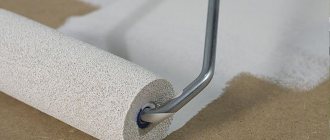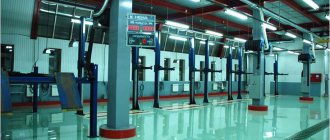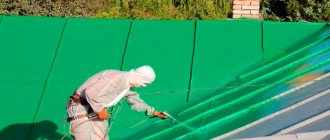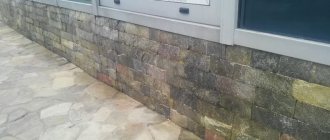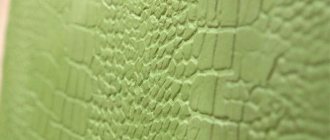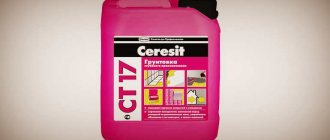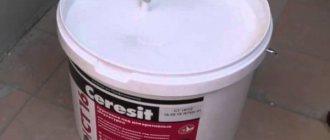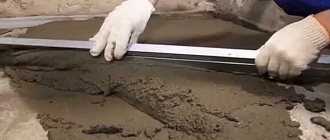Why do you need to prime the floor?
Concrete pavement is the most common type of floor surface. This popularity is explained by a large number of advantages, but it is also important to take into account the disadvantages of concrete. It does not have waterproofing properties, so its porous structure quickly absorbs moisture, under the influence of which deformation processes begin to develop.
The expected effect of a self-leveling floor may never occur, because failure to use a primer can lead to the formation of fungi, unpleasant odors, and mold. If a large amount of water forms, the self-leveling floor may rise, which will lead to the need for repeated repairs.
To avoid undesirable consequences, it is better to do everything correctly from the beginning and prime the rough base before you start pouring the self-leveling floor.
The need for priming before pouring the screed
By using priming immediately before installing the screed, you can achieve the following results:
- bind dust and dirt;
- strengthen the surface;
- reduce absorbency as much as possible;
- increase adhesion;
- achieve high antiseptic characteristics.
Experts recommend applying an adhesive primer before pouring the screed. Popular product "Concrete-contact". This screed primer will make your concrete floor more effective.
How to prime? The first step is to prepare the composition - there are quartz particles in the soil, and during storage they can settle. To ensure uniformity of the material, it is recommended to thoroughly mix the mass before use.
Is it possible to pour a self-leveling floor without a primer, possible consequences
Theoretically speaking, the process of forming a self-leveling floor can occur without prior priming. But if we consider this possibility from a practical point of view, all masters agree that soil is a must. It guarantees long-term use of the surface. Otherwise, the new floor may not last even a year, as various defects will begin to form on its surface.
Application of a primer provides:
- high level of adhesion of the screed to the base;
- dust removal;
- reducing the absorbency of the base, in other words, the base of the floor will not quickly absorb moisture from the screed, thereby allowing enough time for complete drying;
- antifungal properties;
Combination with floor coverings
Each person has their own taste preferences. During renovations, many people quite actively use tiles, which can be used to decorate a wide variety of surfaces without any problems. In this case, you need to figure out whether it is necessary to prime the floor before laying the tiles and how to act in this situation. In this case, soil mixtures are applied to significantly improve the adhesion between the cladding and the base. Of course, you can lay tiles on cement mortar the old fashioned way, but practice shows that the corresponding method is clearly inferior in many respects to modern soil mixtures.
Quite common floor coverings today are linoleum and laminate. In this case, it is also impossible to do without preliminary preparation of the foundation. It is not enough to know whether it is necessary to prime the floor before laying linoleum, because you still need to approach the corresponding process correctly. Linoleum is known to have an attractive appearance and low cost compared to other coating options. Thanks to pre-priming, the corresponding material will also experience a significant improvement in its own technical parameters.
When to use a deep penetration primer
This type of primer is used during the process of pouring the floor, in rooms with high levels of humidity and frequent changes in temperature conditions. Such premises include baths, saunas, and swimming pools. Since the floor here is in constant contact with water, standard soil for a domestic space is not enough; it is the deep penetration effect that is important. Application of the composition makes it possible to clog the wide pores of concrete, thereby creating an additional protective layer responsible for the safety of the coating.
Types of concrete bases
There are different types of concrete floors, each requiring the use of different primers. A monolithic concrete base has a high density of the top layer; usually a monolithic concrete floor is shiny. This base absorbs moisture very poorly; if it is not primed, then it is practically useless to apply any finishing material; it will peel off anyway. To prepare such a floor, you need to use a primer for surfaces that do not absorb moisture well, or you need to thoroughly sand the floor.
Concrete screeds are a lightweight type of screeds that are filled with expanded clay or crushed stone. Such a floor must be treated with a deep penetration primer that strengthens the base as much as possible. It is this type of soil that will penetrate deeply into all the pores of the concrete.
Primer selection criteria
In order to correctly select the optimal type of primer, you need to carefully analyze the selection criteria:
- Type of base – concrete, cement screed, tile, wood. For each of these coatings, there are different types of primers, characterized by special compositions. Particular attention should be paid to the last two bases, as they have a weak level of adhesion and strength.
- Room type. For office and domestic premises with a normal microclimate, it is optimal to give preference to concrete contact, but for premises characterized by a high degree of humidity, it is worth purchasing deep penetration soil.
- Price. The choice based on this criterion is quite subjective, but you should not focus on options that are too cheap; they may be of dubious quality.
- Easy to use and easy to apply. This criterion is especially important for those who will independently carry out the priming process without experience or skills in this type of activity.
Popular primer manufacturers (briefly)
The surface should be primed before pouring with a quality product, then you can be sure that the coating will last longer. There are a large number of primer compositions on the construction market, but not all of them are of good quality or high stability.
If the process is to be done with your own hands, then it is better when choosing to focus on popular brands that have proven themselves to be high-quality mixtures among consumers. You can highlight the products of the brands Ceresit, Knauf, Bergauf, you can also highlight the domestic manufacturer Volma, which produces a series of Nivelir primers, kg. the mixtures are not expensive, and their quality is high.
When choosing, you should study the instructions from the manufacturer, which indicate for which materials it is better to use a specific type of primer solution.
The surface should be primed before pouring with a quality product, then you can be sure that the coating will last longer.
What primers are used?
Today, the building materials market offers a wide range of primers for self-leveling floors. All of them are presented by different manufacturers, have different composition and cost.
Among the most popular types of soils are:
biocidal – has a high degree of penetration, long service life, and is also characterized by antifungal properties;
polyurethane - has economical consumption, but the cost of such a substance is slightly higher than its analogues. Among the main advantages are protection against the formation of oily stains and excellent adhesion to the tiled surface.
silicone – has the highest degree of water repellency. When applied to the base, it quickly penetrates deep inside, displacing existing moisture. After it dries, all pores are reliably protected from re-entry of moisture.
concrete contact – has increased adhesion and a crystallizing effect. Can be used for rooms with normal microclimate, does not have a high level of protection against humidity.
hydrophobic - demonstrates high adhesion, but its contact with alkali is not desirable, as this may lead to the need to update the layer.
Preparing the floor surface before applying primer
The quality of the base coating preparation determines the quality of the poured floor.
The quality of the base coating preparation depends on the quality of the poured floor. Therefore, a concrete or cement floor must go through the following processing stages before a primer is applied before self-leveling the floor:
- All old loose coating is removed from the surface to the base;
- The surface is cleaned of construction debris (dust, dirt, pieces of old mortar);
- A cement-sand floor screed is produced;
- After complete drying, the surface is cleared of sagging, the seams are smoothed;
Advice! To check whether the floor screed has dried, place a piece of film measuring at least 1 square meter on its surface. meters and is attached to the surface with tape. After 24 hours, if no moisture has formed under the film, it means the screed has completely dried.
- The entire surface is sanded and cleaned of dust using an industrial vacuum cleaner. The quality of the self-leveling floor depends on the correct grinding;
- When the surface is prepared for pouring the self-leveling polymer mixture, the surface must be treated with a special deep penetration primer.
At this stage of repair, many people have questions about whether it is necessary to prime before self-leveling the floor and what the benefits of treating the surface with primer will be.
Why do you need to prime concrete?
Concrete coating has an increased ability to absorb moisture
Note: Due to its properties, concrete coating has an increased ability to absorb moisture, but, unfortunately, this is a significant drawback. After all, when any mixture is applied to the base, its moisture is instantly absorbed into the floor, and, consequently, the bonding of the materials to each other deteriorates. Also, the remaining moisture after drying can raise the self-leveling floor, thereby requiring replacement of part of the coating or the entire surface.
Therefore, the main requirement for a primer is to close the micropores in the concrete surface, as well as to prevent moisture from entering. Any deep penetration primer designed for concrete surfaces will cope with this task.
Why do you need deep penetration soil?
When repair work is carried out in rooms with a special microclimate, for example, swimming pools, saunas or bathrooms, then a primer for self-leveling floors is used only for deep penetration. You can also use liquid glass. The use of such soil allows you to create a waterproofing layer on the concrete surface.
Polyurethane self-leveling floor: types, composition and filling technology
Advice: For ordinary premises, concrete-contact impregnation is sufficient.
Primer technology
Regardless of the type of primer mixture chosen, the technology for its application is carried out in accordance with the following steps:
- Consideration of the characteristics of the base . Carrying out an inspection allows you to choose the optimal soil composition, taking into account the base material, as well as the type of self-leveling floor. In some situations, it is possible to use two types of soil on one base.
- Preparing the base . Before applying the mixture, the floor surface must first be cleaned, leveled, sanded, and all visible defects must be eliminated.
- Application of primer . The application process occurs using a roller, brush, or a special spray apparatus.
- Applying the second layer . During the drying process, you should pay attention to the uniformity of this process. If there are areas where drying occurs faster, then a recoat may be necessary.
How to calculate consumption
To find out how much product will be needed to prime the entire floor surface, calculate the area in advance. Each manufacturer indicates on the packaging the average consumption of their product. The base material is also taken into account; the more porous the floor covering is, the higher the primer consumption will be.
The consumption is affected by the constituent components of primer mixtures. To make the calculation easier, you can use an online calculator, which can be easily found on the Internet. Typically, the first layer requires applying 200-500 milliliters of product per square meter of area. The following layers require less solution, approximately 100-200 milliliters.
The more porous the floor covering, the higher the primer consumption will be.
Recent Entries
A primer is a specific liquid material that is designed to significantly improve the adhesion of various coatings. It is easy to understand whether the floor needs to be primed, because after the appropriate procedure, you can lay various coatings with confidence in the durability. In addition to its main function, the primer can slow down the process of water absorption. As a result, the screed will maintain its uniformity for as long as possible, and will also reduce the likelihood of its subsequent cracking.
Types of primer compositions used for floors
Specialized types of primers with different bases are used for flooring:
- Alkyd primer is most often used when working on wood floors before painting them. The drying time for the soil is approximately 10 hours.
Important! If the floor will be painted with alkyd paint, you need to choose a zinc phosphate-based primer. When using other coloring compositions, you should buy a composition with zinc chromate.
- Acrylic primer is considered the most universal, it is a deep penetration composition and is used for treating brick, wood, cement, plastered surfaces, fiberboard and chipboard, and concrete floors. Its advantages include the possibility of dilution with water, lack of odor, and ease of application. Drying will take from 2 to 5 hours.
Cement-sand and concrete bases
Sand and cement screed and concrete base need such impregnation. The humidity in them should not exceed 4%. After impregnation, the base must be thoroughly dried. The concrete base is cured for 28 days.
In a damp base, after covering it with a self-leveling mixture, there is nowhere for water to evaporate and it becomes blocked, which negatively affects the quality of the self-leveling floor. In addition, the surface for the self-leveling floor should not contain oil or grease stains.
